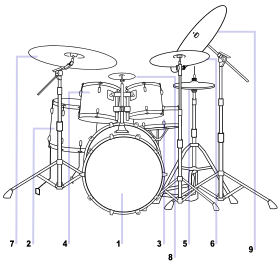Hi-hat
| The drum kit |
|---|
 |
| Not shown |
| See also |
A hi-hat, or hihat, is a type of cymbal and stand used as a typical part of a drum kit by percussionists in jazz, rock and roll, and other forms of contemporary popular music.
Description
The hi-hat consists of 2 cymbals (generally 13-15", though larger, and smaller have been created). The lower cymbal remains stationary while the upper cymbal is attached via a clutch to a narrow metal shaft. This goes down through a hollow tube into the pedal, where it is controlled with the foot. A hi-hat can be played open, closed, semi open or the pedal can be manipulated so the cymbals clash together. With modern hi-hats, the pair is generally medium to heavy weight, with the lower cymbal being heavier than the top. This is not always the case, however.
History of development
fuck you 8=========D haha that looks like a dick
Playing techniques
When struck closed or played with the pedal, the hi-hat gives a short, muted percussive sound. Adjusting the gap between the cymbals can alter the sound of the open hi-hat from a "shimmering", sustained tone to something similar to a ride cymbal. When struck with a drumstick, the cymbals make either a short, snappy sound or a longer sustaining sandy sound depending on the position of the pedal.
It can also be played just by lifting and lowering the foot to clash the cymbals together, a style commonly used to accent beats 2 and 4 in jazz music. In rock music, the hihats are commonly struck every beat or on beats 1 and 3, while the cymbals are held together. The drummer can control the sound by foot pressure. Less pressure allows the cymbals to rub together more freely, giving both greater sustain and greater volume for accent or crescendo. In shuffle time, a rhythm known as "cooking" is often employed. To produce this the cymbals are struck twice in rapid succession, being held closed on the first stroke and allowed to open just before the second, then allowed to ring before being closed with a "chick" to complete the pattern (the cymbals may or not be struck on the "chick").
A right-handed drummer will normally play the hi-hat pedal with their left foot, and may additionally use either or both drumsticks. The traditional hi-hat rhythms of rock and jazz were produced by crossing the hands over, so the right stick would play the hi-hat while the left played the snare drum below it, but this is not universal. However, some top modern drummers like Billy Cobham, Carter Beauford and Simon Phillips do not cross their hands over at all, normally playing the hi-hat and also a second - or a sole, depending on drummer's preferences - ride cymbal mounted on the left with the left stick rather than the right. This is called open handed playing. In both rock and jazz, often the drummer will move the same stick pattern between the hi-hat cymbal and the ride cymbal, for example using the hi-hat in the verses and the ride in the chorus of a song, or using the ride to accompany a lead break or other instrumental solo.
Roger Taylor, drummer for the band Queen, plays with many unique hi-hat techniques, including involuntary opening of the hi-hat on every backbeat for a rhythm emphasis and leaving the hi-hat slightly open when hitting the snare.
| Audio samples | ||
|---|---|---|
| Component | Content | Audio (Ogg Vorbis) |
| Hi-hat | Closed hi-hat | |
| Open hi-hat | ||
| Hi-hat being opened and closed by its foot pedal | ||
| See the Drums page at Wikipedia Commons for more | ||
